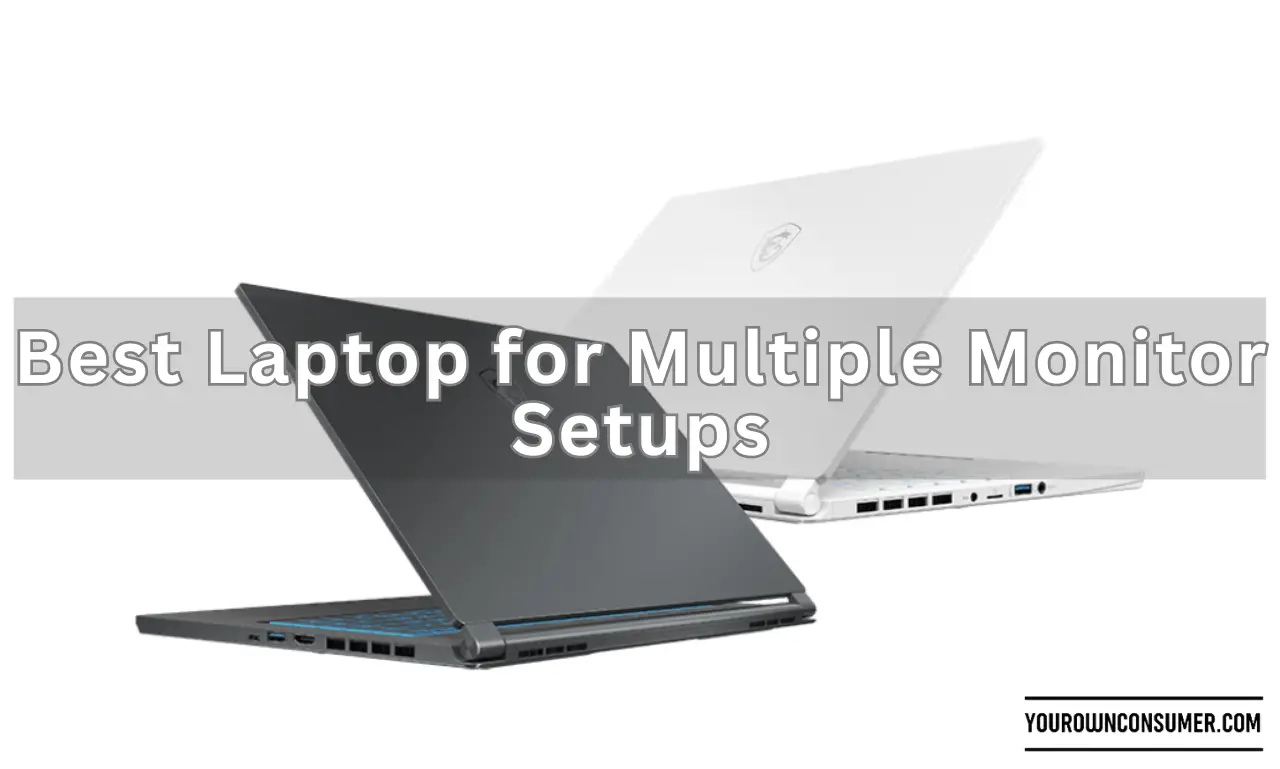Are you looking for the best laptop for multiple monitors? If so, you’ve come to the right place. With the right laptop, you can use multiple monitors to significantly increase your productivity. But with so many laptops on the market, it can be hard to know which one is best for your needs. In this article, we’ll break down which laptops offer the best features and performance when it comes to powering multiple monitors. You’ll find all the information you need to make an informed decision and get the most out of your multi-monitor setup. So let’s get started!
Image | Reasons to Buy | Our Rating | Buy Link |
Dell XPS 15″ 9530  |
| ||
MacBook Pro 14 M2 Pro  |
| ||
MSI Stealth 15M  |
| ||
Dell Alienware M15 R7  |
| ||
HP Spectre x360  |
|
Definition Of Multiple Monitors
Multiple monitors are computer displays that are connected to a single computer. They can be used to create a larger workspace, allowing users to view multiple applications simultaneously. This is usually done with one monitor acting as the main display and the other monitor being used as an auxiliary device. Multiple monitors can be used for gaming, productivity, or entertainment purposes.
The setup of multiple monitors is simple and straightforward. To connect two or more monitors to one computer, you will need a video card with at least two video outputs and cables to connect them. You may also need additional components such as an adapter or splitter if you’re connecting more than two monitors. Once these are connected, each monitor will display its own image.
In order to get the best performance out of your multiple monitor setup, it’s important to invest in high-quality hardware such as graphic cards and cables. Additionally, you should make sure your computer meets all requirements for running multiple monitors smoothly. With the right hardware and software configuration, you’ll be able to enjoy the benefits of having multiple displays without any issues.
Benefits Of Using Multiple Monitors
Using multiple monitors offers a variety of benefits that can make work and leisure activities more efficient. For starters, having multiple displays allows for multitasking; with two or more screens, users can view multiple windows at the same time, eliminating the need to switch between applications. This helps them save time and energy when working on complex tasks. Additionally, using multiple monitors can help improve productivity and minimize errors in tasks that require a lot of attention to detail as it allows users to spread out their work across different screens. Finally, having two or more displays also makes it easier to compare information side-by-side, which is especially useful when dealing with large documents and data sets.
When it comes to gaming, using multiple monitors can also provide a better experience. A larger display area gives gamers the ability to see more of the gaming world at once, allowing for better reactions and improved accuracy when playing fast-paced games. Furthermore, with bigger screens, gamers can enjoy higher resolutions and get a more immersive experience overall. Lastly, having two or more monitors connected to one computer makes it possible for players to have different views without needing to buy additional hardware.
Overall, there are many advantages of using multiple monitors and they should be considered if you need extra space on your desktop or want an enhanced gaming experience. Whether you’re looking for increased productivity while working or just want a larger view while playing your favorite games, investing in a laptop with support for multiple displays is sure to be worth it in the long run.
Specifications To Look For While Choosing the Best Laptop for Multiple Monitors
When searching for the best laptop for multiple monitors, there are certain specifications to look for. First and foremost, the laptop should have a powerful processor and a powerful graphics card to power multiple displays. An Intel Core i7 or equivalent and a GTX 1660 Ti or higher are recommended as it offers fast performance and multitasking capabilities. It should also have at least 8 GB of RAM which will help ensure smooth operation when running multiple applications simultaneously.
In addition to a powerful processor, GPU and ample RAM, the laptop should also come with plenty of storage space. A minimum of 256GB SSD is recommended to ensure enough room for all your programs and files. Depending on how much space you need, you may want to opt for even more storage capacity such as a 512GB SSD or even a 1TB HDD.
The laptop’s display size is also important when it comes to using multiple monitors. Look for at least 15-inch screens which will allow you to see more details when viewing multiple windows side-by-side. Furthermore, make sure the display has a high resolution that can support up to 4K so you can enjoy crystal clear visuals on each monitor.
Ultimately, these are just some of the specs you’ll need to consider when shopping for the best laptop for multiple monitors. Be sure to read reviews and compare prices before making your purchase so you can get the most value out of your money.
Operating System Requirements
When shopping for a laptop for multiple monitors, it’s important to consider the operating system requirements. Different monitors may require different operating systems. Windows 10 is the most popular and recommended option for use with multiple monitors, but there are other options available. Linux and MacOS are also popular choices.
Each operating system has its own advantages and disadvantages. Windows 11 is well known for its user-friendly interface and extensive compatibility with various hardware and software programs. Additionally, Windows 11 can be used to set up dual or multiple displays in a single session, allowing users to increase productivity. On the downside, Windows 11 can be more resource-intensive than other options like Linux or MacOS.
Linux is another popular operating system choice for multiple monitors. It offers a robust set of features that make it ideal for power users who need access to advanced tools and applications that may not be available on Windows or MacOS. Linux is generally less resource-intensive than Windows and can offer great performance when running multiple monitors simultaneously. However, it lacks the same level of user-friendly support as Windows 11.
MacOS is the third option available for multiple monitor setups. It has excellent display capabilities, making it ideal for creative professionals who rely heavily on visuals in their workflows. The downside of MacOS is that it tends to be more expensive than other operating systems, making it less budget-friendly than some alternatives like Linux or even Windows 11 in some cases.
Processor And Memory Requirements
When selecting the best laptop for multiple monitors, processor and memory requirements are important to consider. The processor should offer a minimum of 2GHz, however, more powerful processors are available that can provide better performance. For the best results when using multiple monitors, look for a laptop with at least an Intel Core i5 or AMD Ryzen 5 processor. This type of processor is capable of handling simultaneous tasks without lagging or slowing down.
In addition to the processor, having enough RAM is essential for running applications with multiple monitors. Look for laptops with at least 8GB or 16GB of RAM. This will ensure that applications run smoothly and efficiently across multiple monitors without any lag time. It’s also important to consider whether you’ll need additional storage space, such as a hard drive or SSD drive, depending on your needs.
Finally, make sure to select a laptop that has enough power ports so that you can easily connect your desktop monitor and other devices to the laptop. Make sure that the laptop has USB 3, USB C, and Display ports as well as HDMI connections so you can easily plug in all of your devices without worrying about compatibility issues. Well, you still might need to buy an adapter if you plan to setup more than one monitor, as in most laptops the display/HDMI ports are limited to one.
Graphics Card Requirements
When it comes to finding the best laptop for multiple monitors, the graphics card is one of the most important considerations. The type of graphics card needed will depend on the types of tasks you plan to do with your laptop and how many monitors you want to connect. To ensure your laptop can handle multi-monitor usage, it’s important to choose one with a powerful dedicated graphics card.
For most uses, an NVIDIA GeForce GTX 1660 Ti or an AMD Radeon RX 560X should be enough. If you’re planning on running more intensive applications such as video editing or 3D modeling, then you’ll want something even more powerful like an NVIDIA RTX 2070 or higher. For gaming, look for a GTX 1660 Ti or higher. All these GPUs should be able to handle at least two external displays with ease.
If you need to connect more than two monitors, then consider a laptop that has dual graphics cards like an NVIDIA SLI setup or an AMD Crossfire setup. This will allow you to connect up to four external displays without sacrificing too much performance. Choosing the right graphics card is essential if you want your laptop to be capable of handling multiple displays efficiently and without any hiccups.
Ports And Connectivity Options
When shopping for the best laptop for multiple monitors, it’s important to consider the ports and connectivity options available. Many laptops come with a variety of output and input ports, such as HDMI, USB, Display Port, and Thunderbolt. If you plan on connecting multiple monitors to your laptop, you’ll need to make sure your PC has enough ports to accommodate them.
For example, if you plan on using two external monitors with your laptop, then having two HDMI ports or two USB-C ports is ideal. Additionally, if you’re looking to connect multiple displays that support higher resolutions and refresh rates (such as 4K or 8K displays), then look for a laptop with Thunderbolt 3 ports. These will allow you to connect up to 6 external displays at once.
Finally, some laptops also come with wireless display technology such as Miracast or Intel WiDi (Wireless Display). This allows you to wirelessly connect compatible displays without the need for additional cables or adapters. This feature can be very useful in scenarios where you don’t have access to enough ports for your monitors.
No matter what type of laptop you choose, make sure it has enough ports and connectivity options to meet your needs.
Battery Life Considerations
Considering battery life when shopping for a laptop is an important factor. After all, if the laptop will be used on the go, it needs to have enough battery power to last throughout the day. Many laptops come with long-lasting batteries that can give you up to 8 hours or more of use. However, some laptops may not offer as much battery life as others. It’s important to compare different models and take into account how much time you’ll be spending away from a power source when looking for a laptop with multiple monitors.
Although if you are planning to buy a laptop for the sole purpose of using multi monitor setups, you are more likely to keep the laptop at your desk plugged in as moving around with monitors won’t be an easy situation. Nevertheless, whenever you plan to buy a laptop, choosing the one with a good battery life will be beneficial in the longer run giving you more flexibility.
Price Point Considerations
When it comes to price point considerations for the best laptop for multiple monitors, there are a few key factors to keep in mind. First and foremost, the cost of the laptop itself will play a major role. Depending on your budget and needs, you may be able to find an affordable laptop that can handle multiple monitors without breaking the bank. Additionally, you’ll need to factor in the cost of additional hardware such as cables, adapters, and monitors. While these items can add up quickly, it’s important to remember that they’re necessary for a successful multi-monitor setup.
Another factor to consider is the overall quality of the laptop and its components. You want to make sure that you’re purchasing a laptop with reliable hardware that will last for years to come. This includes powerful processors, plenty of RAM, and high-quality graphics cards that can handle multiple monitors simultaneously. It’s also worth looking at reviews from other customers who have purchased laptops in your price range and reading their experiences with running multiple monitors on their machines.
Finally, before making a purchase decision it’s essential to do your research and compare different models across various price points so you can make an informed decision about which one is right for you. Consider all of your options carefully before making a final decision – this will help ensure you get the most out of your investment in terms of performance and longevity.
Best Laptops for Multiple Monitors 2023- Tried and Tested
Taking price point considerations into account, there are a number of popular brands and models to consider when it comes to selecting the best laptop for multiple monitors. Dell, HP, and Apple all offer a range of models with different specs and features that can fit different needs.
Dell’s XPS 13 is considered one of the best laptops for multiple monitors, as it features a high-quality display and powerful processor. It also has plenty of ports to connect external devices. The MSI Stealth is another great option, as it boasts an impressive battery life and fast performance. It also has a sleek and gamer design that will appeal to many users. Lastly, Apple’s MacBook Pro 16 provides excellent power and speed, plus offers great visuals with its retina display.
Dell XPS 15 – 2023 Model- Our Pick for Best Overall Laptop
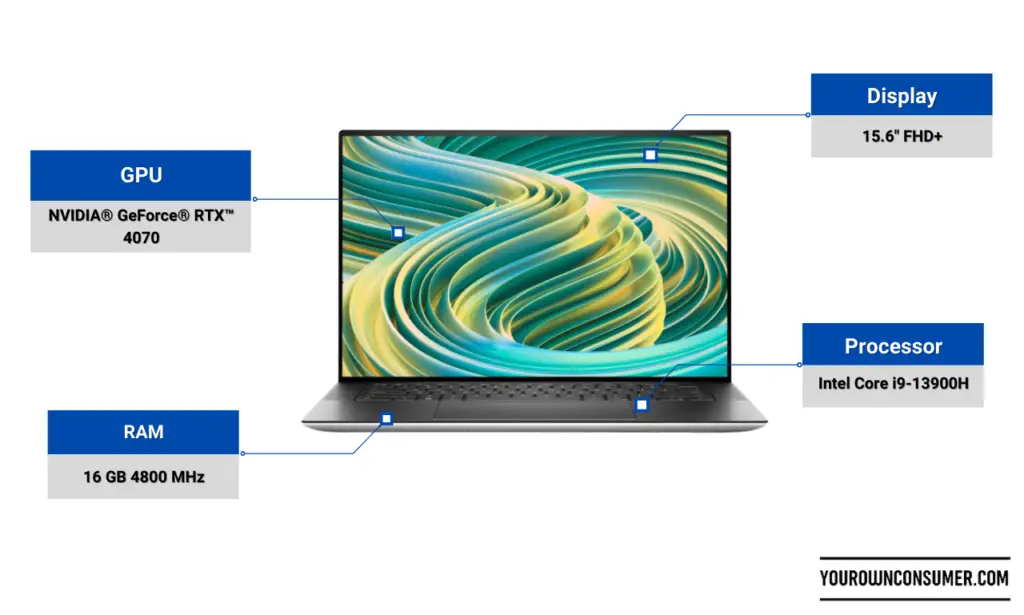
If you’re in search of a highly powerful and reliable laptop, the Dell XPS 15 is an excellent choice with its 13th Generation Intel Core i9 processor. Its battery life is great, and it can handle multiple tasks with ease. It comes with 16GB of RAM and 512GB of storage, but you also have the option to choose from variants with 32GB or 64GB RAM, and 1TB, 2TB, 4TB, or a massive 8TB storage capacity for those needing extra space.
| Component | Specification |
|---|---|
| Processor | 13th Generation Intel® Core™ i9-13900H Processor 14-Core, 24MB Cache, up to 5.4 GHz |
| Graphics Card | NVIDIA® GeForce® RTX™ 4070 with 8 GB GDDR6 |
| Display | 15.6″ FHD+ (1920 x 1200) InfinityEdge Non-Touch Anti-Glare, 500-Nit Display |
| RAM | 16 GB, 2 x 8 GB, DDR5, 4800 MHz, dual-channel |
| Hard Drive | 512GB M.2 PCIe NVMe Solid State Drive |
| Support | 1 Year Premium Support |
| Keyboard | Backlit Black English Keyboard w/ Fingerprint Reader |
| Ports | 1 USB 3.2 Gen 2 Type-C™ port with DisplayPort™, 2 Thunderbolt™ 4 (USB Type-C™ 3.2 Gen 2) ports, 1 headset port. |
| Slots | 1 SD-card slot, 1 Wedge-shaped lock slot |
| Camera | 720p at 30 fps, HD camera |
| Audio and Speakers | Stereo woofer 2.5 W x 2 and stereo tweeter, 1.5 W x 2= 8 W total peak |
| Wireless | Intel® Killer™ Wi-Fi 6 1675 (AX211) 2×2 + Bluetooth 5.2 |
| Primary Battery | 6-Cell Battery, 86WHr (Integrated) |
| Power | 130Watt Type-C Adapter |
Most importantly it comes with 2 Thunderbolt 4 ports and 1 USB 3.2 Gen Type C display port. So technically, you can connect 3 external displays at the same time using the available ports on the laptop. This makes it one of the most versatile and powerful laptops that are currently available in the market. It also comes with an HDMI v2.0 adapter inside the box to offer you more display connectivity options if your monitor does not support a display port.
MacBook Pro 16 M2 Pro 2023 Model – Our Pick for Best Everyday Laptop
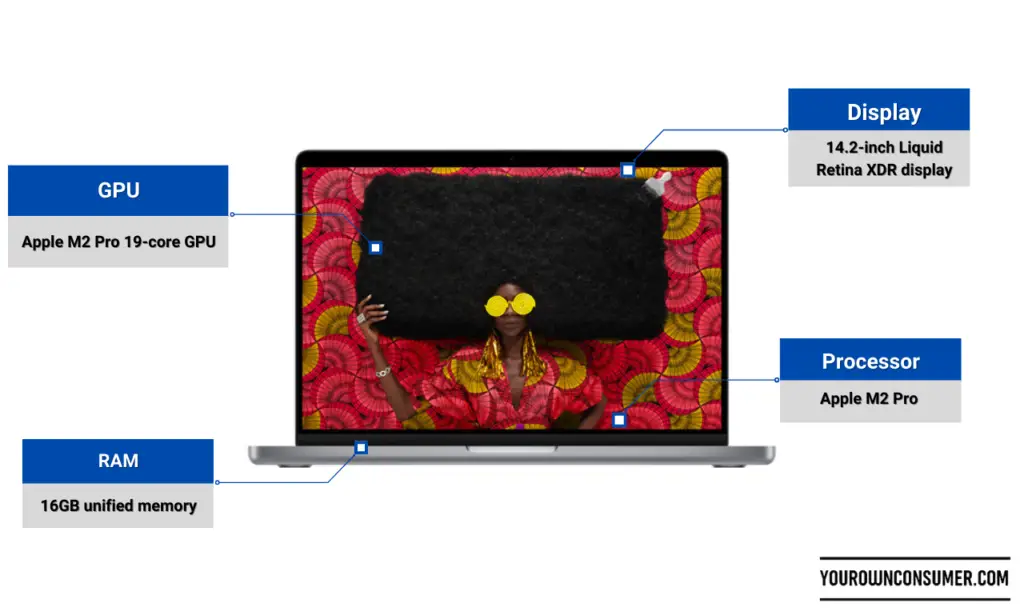
| Component | Specifications |
|---|---|
| Processor | Apple M2 Pro chip; 12-core CPU with 8 performance cores and 4 efficiency cores, 19-core GPU, 16-core Neural Engine, 200GB/s memory bandwidth |
| Display | 16.2-inch (diagonal) Liquid Retina XDR display; |
| RAM | 16GB unified memory (Configurable up to: 32GB) |
| Battery | 70-watt-hour lithium-polymer battery3, Fast-charge capable with 96W USB‑C Power Adapter |
| Storage | 1TB SSD (Configurable to: 2TB, 4TB, or 8TB) |
| Ports | HDMI port, 3.5 mm headphone jack, MagSafe 3 port, Three Thunderbolt 4 (USB-C) ports with support for: Charging, DisplayPort, Thunderbolt 4 (up to 40Gb/s), USB 4 (up to 40Gb/s) |
| Keyboard and Trackpad | Backlit Magic Keyboard, Touch ID, Ambient light sensor, Force Touch trackpad for precise cursor control and pressure-sensing capabilities; enables Force clicks, accelerators, pressure-sensitive drawing, and Multi-Touch gestures |
| Connectivity | Wi-Fi 6E (802.11ax)5, Bluetooth 5.3 |
| Camera | 1080p FaceTime HD camera, Advanced image signal processor with computational video |
| Audio | High-fidelity six-speaker sound system with force-canceling woofers, and Wide stereo sound |
The MacBook Pro 16″ M2 Pro can support multiple external displays. You can connect up to two external displays with up to 6K resolution at 60Hz via Thunderbolt, or one external display with up to 6K resolution at 60Hz via Thunderbolt and one external display with up to 4K resolution at 144Hz via HDMI. Alternatively, you can connect one external display at 8K resolution at 60Hz or one external display at 4K resolution at 240Hz via HDMI.
MSI Stealth 15M A11SDK-063- Our Pick for Best Value for Money
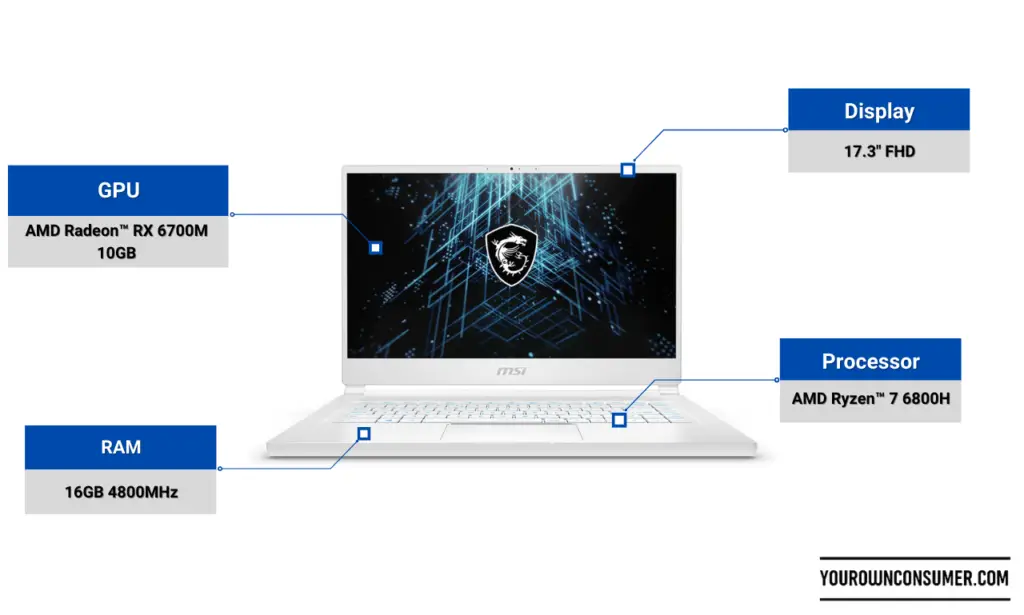
The new Stealth 15M gaming laptop is designed with urban style in mind, and it is the thinnest and lightest 15-inch model available in either Carbon Gray or Pure White. It runs on the latest 11th Gen. Intel® Core™ i7 processor and NVIDIA® GeForce® GTX 1660 Ti with Max-Q Design graphics, making it the perfect balance of portability and performance. The laptop also features new-generation technology, including PCIe Gen 4 and Thunderbolt™ 4.
| Component | Specification |
|---|---|
| CPU | Core i7-1185G7 |
| Display | 15.6″ FHD (1920*1080), IPS-Level 144Hz 45%NTSC Thin Bezel |
| GPU | NVIDIA® GeForce® GTX 1660 Ti (Max-Q) 6GB GDDR6 |
| Keyboard | Single zone RGB keyboard with Anti-Ghost key (84 Key) |
| Audio | Nahimic 3 / Hi-Res Audio, Nahimic Hi-Res Audio Speakers 2W * 2 |
| RAM | 16GB (8G*2) DDR4 3200MHz |
| Storage | 512GB NVMe SSD |
| Connectivity | Intel Wi-Fi 6 AX201(2*2 ax), BT 5.1 |
| Camera | 720p HD Webcam |
| Ports | 2x USB 3.2 Gen1, 1x Thunderbolt™ 4, HDMI™ (supports 4K @ 60Hz) |
| Battery | 3 cell (52Whr), 150W Slim fast charging |
Gamers and young professionals alike will appreciate the new Cooler Boost 5 with 0.1 mm thin fan blades, which allows for faster processing of games and daily tasks. With this powerful technology, the Stealth 15M delivers excellent performance while remaining easy to transport. You can connect two external displays natively, 1 using the thunderbolt 4 port and 1 using the HDMI that supports up to 4K 60Hz displays.
Dell Alienware M15 R7 Gaming Laptop- Our Pick for Best AMD Laptop
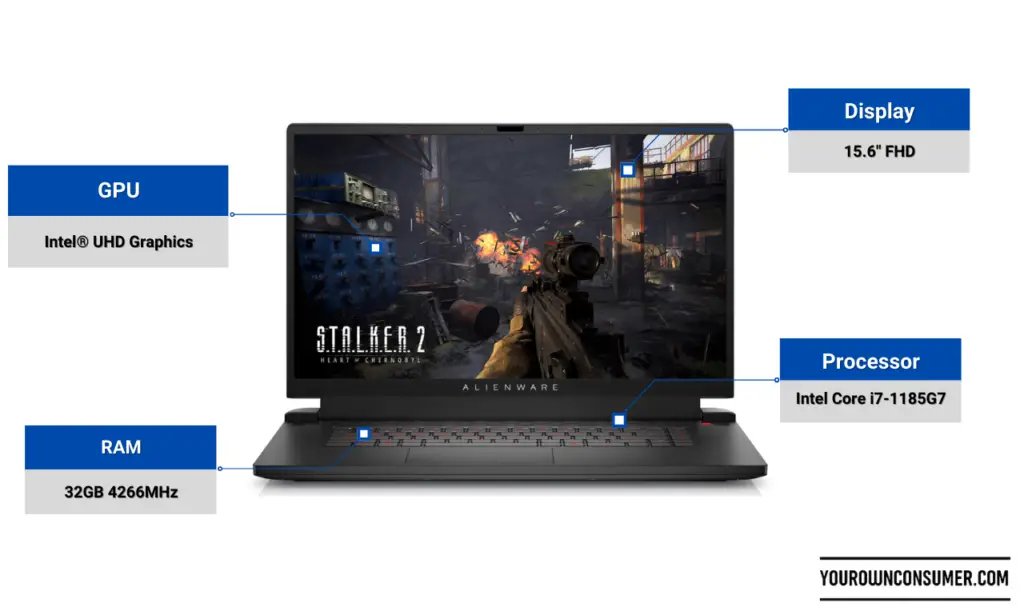
Dell Alienware M15 R7 is the most powerful 17-inch option available with top-of-the-line components such as up to 8-core/16-thread AMD Ryzen 6000 series processors, AMD Radeon graphics, and innovative AMD Smart Technologies. These technologies, including SmartShift Max, Smart Access Graphics, and Smart Access Memory, enhance the overall performance of the system.
| Category | Specification |
|---|---|
| Processor | AMD Ryzen™ 7 6800H (20 MB total cache, 8 cores, 16 threads, up to 4.70 GHz) |
| Operating System | Windows 11 Home, English |
| Graphics Card | AMD Radeon™ RX 6700M 10GB GDDR6 |
| Display | 17.3″, FHD 1920×1080, 165Hz, Non-Touch, 3ms, AMD FreeSync, ComfortView Plus |
| RAM | 16GB, 2x8GB, DDR5, 4800MHz |
| Hard Drive | 512 GB, M.2, PCIe NVMe, SSD |
| Case | Dark Side of the Moon |
| Microsoft Office | Microsoft Office 30 Day Trial |
| Anti-virus | No Anti-virus Requested |
| Support | 1 Year Premium Support |
| Accidental Damage | None |
| Keyboard | Alienware mSeries per key AlienFX RGB keyboard (English) |
| Ports | 2 Type-A USB 3.2 Gen 1 Port, 1 Type-A USB 3.2 Gen 1 Port with PowerShare, 1 Type-C Port (USB 3.2 Gen 2, DP 1.4, Power Delivery (5V/3A)), 1 HDMI 2.1 Output Port, 1 RJ45 Ethernet port, 1 Power-adapter port, and 1 Headset combo port. |
| Camera | 720p at 30 fps HD camera (with 165Hz FHD panel) |
| Audio and Speakers | Stereo speakers, 2.5 W x 2 = 5 W |
| Keyboard Options | Alienware M Series keyboard with one-zone RGB LED AlienFX lighting |
| Touchpad | Multi-touch gesture touchpad with integrated scrolling |
It also has a display 1.4 port and HDMI 2.1 output port which would help in connecting two external displays natively.
HP Spectre x360 2-in-1 Laptop 14″ – Our Pick for Best Budget Laptop
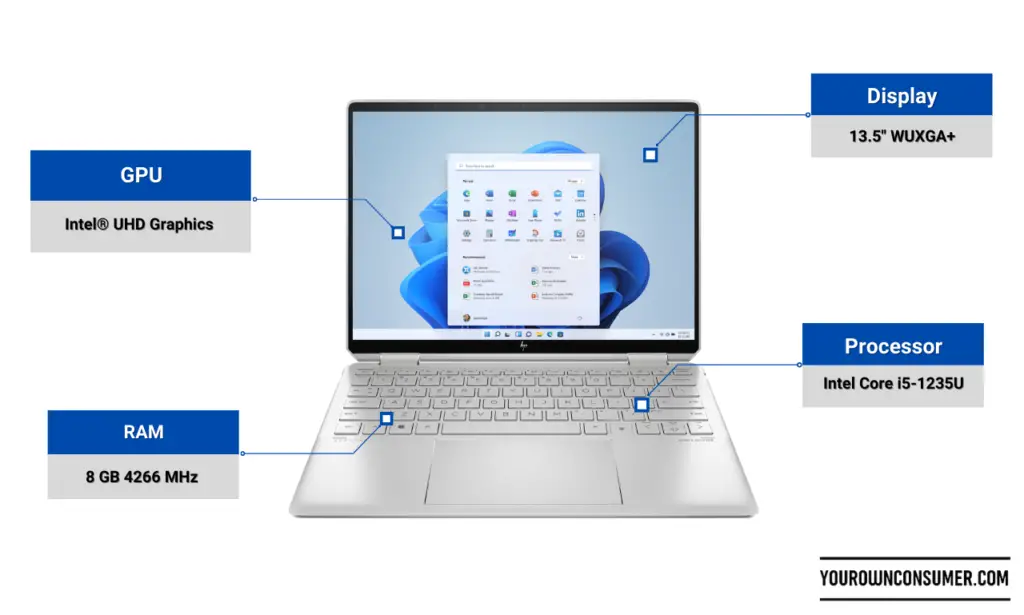
The HP Spectre x360 13.5″ combines breathtaking design and robust performance. Its versatile 360° design allows you to find the optimal position, and its advanced camera features ensure you always look your best during live video. You can also unify your devices with the HP Palette software suite. This machine is both powerful and eco-friendly, featuring the Intel® Evo™ certified Platform.
| Specifications | Details |
|---|---|
| Processor | Intel® Core™ i5-1235U (up to 4.4 GHz with Intel® Turbo Boost Technology, 12 MB L3 cache, 10 cores, 12 threads)[6,7] |
| Graphics | Integrated: Intel® UHD Graphics |
| Display | 13.5″ diagonal, WUXGA+ (1920 x 1280), multitouch-enabled, IPS, edge-to-edge glass, micro-edge, anti-reflection Corning® Gorilla® Glass NBT™, Low Blue Light, 400 nits, 100% sRGB[17] |
| Fingerprint reader | Fingerprint reader |
| RAM | 8 GB LPDDR4x-4266 MHz RAM (onboard) |
| Storage | 512 GB PCIe® NVMe™ TLC M.2 SSD[21] |
| Wireless technology | Intel® Wi-Fi 6E AX211 (2×2) and Bluetooth® 5.3 wireless card (supporting gigabit data rate)[11,12,13] |
| Power supply | 65 W USB Type-C® power adapter |
| Battery | 4-cell, 66 Wh Li-ion polymer |
| External I/O Ports | 2 Thunderbolt™ 4 with USB Type-C® 40Gbps signaling rate (USB Power Delivery, DisplayPort™ 1.4, HP Sleep and Charge); 1 USB Type-A 10Gbps signaling rate (HP Sleep and Charge); 1 headphone/microphone combo |
| Expansion slots | 1 microSD media card reader |
| Webcam | HP True Vision 5MP IR camera with the camera shutter, temporal noise reduction, and integrated dual array digital microphones[30] |
| Keyboard | Full-size, backlit, natural silver keyboard |
Additionally, with the Thunderbolt™ solution, you can power your device and connect up to two 4K displays using just one cable. The connection boasts a lightning-fast 40Gbps signaling rate.
Overall, each of these laptops has its own unique features that make them suitable for various use cases. For example, some may be better suited for intensive tasks such as video editing or gaming while others may be more well-suited for everyday tasks like browsing the web or writing documents. Ultimately, which model is best will depend on personal preference and budget constraints.
Frequently Asked Questions
Q. What Is The Difference Between A Laptop And A Desktop For Using Multiple Monitors?
A. When it comes to using multiple monitors, there is a key distinction between laptops and desktops that should be taken into account. The difference lies in the hardware available and the setup involved. Desktop computers generally have more ports and power than their mobile counterpart, allowing for more screens to be connected without much fuss. On the other hand, laptops are more limited in what they can do in terms of connecting additional monitors.
The main difference between a laptop and a desktop when connecting multiple monitors is that desktops typically have more ports available for connection. This means that users can plug in multiple HDMI or DisplayPort cables at once and start using their displays right away. This makes them great for those who need to use multiple monitors on a regular basis, as they don’t need to worry about compatibility issues or buying special adapters. By comparison, laptops usually only have one or two ports, meaning users may need to purchase an adapter to connect all of their extra screens.
Another factor to consider when deciding between a laptop and a desktop for multiple monitor use is the amount of power available from each device. Desktops tend to have more powerful processors, graphics cards, and RAM which can handle the strain of running multiple displays at once. Laptops, on the other hand, tend to be made up of components with lower specs due to their smaller form factor and may not be able to handle heavy multitasking tasks as well as desktops can—particularly if you plan on gaming or doing graphically intensive work with your setup.
Due to these differences in hardware capabilities, those looking for a computer capable of handling multiple monitors may want to opt for a desktop over a laptop if they’re able—though this will depend heavily on individual needs and budget constraints. Ultimately, it’s important to weigh up your options carefully before making any decisions so that you can get the best performance out of whichever type of machine you decide upon for your needs.
Q. Is It Easy To Set Up Multiple Monitors For A Laptop?
Setting up multiple monitors for a laptop can be challenging. It’s important to know all of the components necessary to make it work, and whether your laptop can handle the task. This article will discuss whether it is easy to set up multiple monitors for a laptop and what you should consider before making your purchase.
One of the first things you’ll need to think about is the type of connection ports your laptop has. Most laptops have HDMI, VGA, DisplayPort, or USB-C ports. If you want to connect multiple monitors, you’ll need two or more of these ports. Additionally, if you are connecting multiple monitors with different types of connections, you may need an adapter or cable that is compatible with each monitor’s port type.
When setting up multiple monitors with a laptop, it’s also important to consider the graphics capabilities of the laptop itself. Consider how many pixels each monitor will be displaying and if your laptop has enough power to support them all at once. If not, then you may need to invest in an external graphics card that can support all the displays at once — this could add significantly to your budget.
Finally, it helps to check reviews on any laptop model you’re considering buying before making a purchase. See what other people have said about their experience setting up multiple monitors with that particular model and whether they had any difficulties along the way. This can give you an idea of what kind of setup process might be involved and whether it’s worth investing in that particular laptop model for its multi-monitor capability.
Q. Are Multiple Monitors Supported On All Laptops?
When it comes to laptops, there is often a question of whether or not multiple monitors are supported. In other words, can one use more than one monitor with their laptop? This is an important consideration for anyone looking to create a larger workspace or who needs the convenience of multiple screens.
The short answer is that not all laptops have the capability of supporting multiple monitors. Some models may come with ports for connecting additional displays, while others may require some extra hardware in order to do so. Furthermore, certain laptop models may be limited in terms of how many external monitors they can support at once.
Fortunately, this information can be found relatively easily through research online. For example, manufacturers’ websites will often list the specifications and capabilities of their laptops regarding external monitors. Additionally, user reviews can also provide helpful insights into how well individual models perform when used with multiple monitors.
It is worth noting that there are also options on the market specifically designed for those who want to use two or more external displays with their laptop. These devices plug into your laptop or computer’s USB port and allow you to attach additional screens without any extra hardware or modifications required. While these solutions tend to be pricier than regular laptops, they offer a great deal of flexibility and convenience for users who need extra display space.
Q. Does The Laptop Need To Be Connected To A Power Source To Use Multiple Monitors?
When considering how to best use multiple monitors on a laptop, one of the first questions is whether or not it needs to be connected to a power source. This is an important consideration because it affects the portability and convenience of using multiple monitors with your laptop.
For many laptops, the answer is yes, they will need to be connected to an external power source in order to support multiple monitors. The reason for this is that most laptops are not designed with enough display ports or powerful enough graphics cards to support multiple displays powered solely by the laptop’s battery. This means that if you want the convenience of being able to move around while still using two or more monitors, you will need to make sure your laptop can be plugged into a wall outlet or another power source.
However, there are some laptops that do have powerful enough processors and graphics cards that allow them to drive two or more monitors without needing an external power supply. For example, some gaming laptops come equipped with powerful GPUs and dual monitor ports which can drive two displays at once while running exclusively on battery power. Similarly, some business-class laptops also feature dual monitor configurations and powerful processors which can handle powering multiple displays off battery alone.
So when looking for a laptop capable of supporting multiple monitors, it’s important to consider both its processor speed and graphics card capabilities as well as whether or not you’ll need an external power source in order for it to work properly. Whether you’re buying a laptop for gaming, business use, or other purposes, understanding this distinction will help ensure you get the most out of your new device.
Q. Are There Any Risks Associated With Using Multiple Monitors On A Laptop?
Using multiple monitors on a laptop can be a beneficial way to increase productivity, but there are some potential risks associated with this. It is important to consider these before committing to using multiple monitors on a laptop. In this article, we will explore the potential risks and how they can be avoided.
One of the main risks associated with using multiple monitors on a laptop is overheating. If the laptop’s cooling system isn’t able to keep up with the demands of running two or more screens, then it may overheat and cause components to malfunction or even fail. To mitigate this risk, make sure the laptop has adequate ventilation and that it’s not being blocked by any other objects. Additionally, consider investing in an external cooling pad if necessary.
Another risk when using multiple monitors on a laptop is power consumption. Running two or more screens requires more power than just running one screen alone, so it’s important to ensure that the laptop has enough battery life to handle the additional load. Furthermore, if you’re using your laptop as your primary work machine it’s also worth investing in an external power supply, as this will help reduce battery drain while you’re working.
Using multiple monitors on a laptop can be great for productivity if done correctly but it is important to be aware of the potential risks involved and take steps to mitigate them. Understanding how much power each monitor requires and ensuring that there is sufficient ventilation for the cooling system are key factors in ensuring that your laptop runs smoothly when running multiple monitors.
Final Thoughts on Choosing the Best Laptop for Multiple Monitor Setups
In conclusion, using multiple monitors on a laptop is a great way to increase productivity. It’s important to keep in mind the difference between laptops and desktops when it comes to setting up multiple monitors. While it can be done easily on most laptops, there are certain laptops that may not support the use of multiple monitors. Additionally, it’s important to note that some laptops require an extra power source in order to work with multiple monitors.
Finally, while there are no major risks associated with using multiple monitors on a laptop, it’s always best to take necessary precautions before attempting any installation or upgrades. I recommend researching your particular laptop model before attempting to set up multiple monitors in order to ensure that everything works properly and that you don’t end up damaging your device. Ultimately, if you know what you’re doing and take the right precautions, you can enjoy all the benefits that come with using multiple monitors on your laptop.
